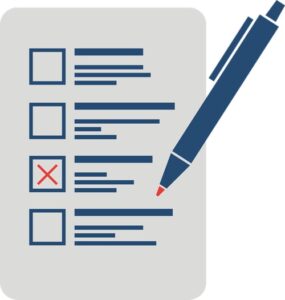Beginning the recruiting process can be intimidating because it’s hard to know where to start. There are so many things you need to spend time doing, but what should be your biggest priority? Until you have a list of colleges you’re interested in playing for, that should be one of your top priorities.
You’re going to create a list of possible colleges you would be interested in playing for that meet at least some of the criteria that are important to you, including the size of the school, geographic location, academic standards, the athletic division they are in, and of course their volleyball program.
There are a few different ways to do this, so read through the ideas and see how you would like to solve this challenge. Although this site is all about volleyball, really the recruiting process is very similar for many sports, so you can use the same ideas to shape how you make your list in any sport.
Step 1 – Identify Your College Preferences
Before you just jump right into making a list, think about your college preferences. This doesn’t mean specific colleges you want to go to, it means what characteristics and qualities you’re looking for in a college, regardless of what name is on the sign out front.
No one except maybe your family can tell you which of these aspects are really right for you. You need to think about which of these factors matter a lot, which ones are somewhat important, and which are no concern at all.
Geographical Location
Some students don’t care where they go to school, but often you have a certain radius from your home that you would like to stay in. Identify either how far you’re willing to go in miles or at least which states you’re willing to consider. It doesn’t mean that if you receive interest from a school outside this footprint you wouldn’t consider it, it just means your goal is to stay within this area.
Size of School
Universities and colleges range from a few hundred to thousands and thousands. Do you want to be in a small, tightly-knit setting or do you want to be part of the anonymous crowd? There are pros and cons each way, it just depends on your taste.
Think about both parts – the class size and the social scene. How well will you want to know your professors, and how large would you like the lecture halls to be? When it comes to making friends, participating in campus activities, and dating life, how comfortable do you feel in a very large setting versus a small pool of people?
Academic Standards

One of the last things athletes usually want to think about when considering colleges is the academic standards, but it’s a vital part of what you need to consider. Does the school have a strong reputation for the program that you’re planning to enter?
Will you be able to qualify to be accepted with your high school grades and ACT scores? Are the standards so high that you may struggle to keep up with classwork during your season? These are real factors that you need to weigh.
Program of Interest
For most 4 year colleges, you can find a general fit for most programs if you are a little flexible. Unless you have a very specific degree you’re seeking, usually, you can find something to work with. Ask these questions early, or research them on the college’s website to see that they offer the degree you’re seeking.
Cost of Attendance
If you haven’t started paying attention to the price tag yet, buckle up! There’s a massive range in cost from one school to the next. One of the biggest parts to consider is that you want to be comparing the total cost of attending the school.
In some cases, it’s tempting to only look at the tuition, but you’re not just going to pay for classes. You need to pay for room & board, books, other administrative fees, and probably travel to and from home on occasion. Does the school charge a different fee for out-of-state tuition? All of these are part of what you’re comparing if you eventually do get offered a scholarship.
Social Fit
As mentioned above, part of the consideration here is size, but there’s more to it than that. What is the culture of the school and community, and does that suit you? Is this a military school? An all men’s or all women’s college? Is it in the middle of the city or in a secluded small town?
Depending on the region of the country, you may have some culture shock. For example, people moving to the south are often surprised how the culture tends towards Christian values. People moving to the north may feel like the culture is more impersonal and cold. Either way can be fine, you just have to decide if it’s right for you.
But don’t just assume that a school in a particular region of the country is going to follow those kinds of stereotypes, try to get a feeling for each specific school what their culture really is.
Size of City
To some extent, a college campus is often like a small town to itself. But every school is a part of the community around it and that makes a big difference. Make sure that you’re looking at schools that are in locations that you feel drawn to and comfortable with.
Athletic Division Level
When you entering the recruiting process, it can be helpful to have an idea of what level you should be looking at. If you don’t know, ask your coaches what would be realistic. You can certainly still include some schools in the other leagues if they meet your other criteria, but the majority of your list should be for schools that fit your athletic ability.
The different divisions are:
| NCAA Division 1 | Most Competitive | Only full scholarships for volleyball |
| NCAA Division 2 | Wide range of competition | Flexible partial athletic scholarships |
| NAIA | Wide range of competition | Flexible partial athletic scholarships |
| Junior Colleges | Wide range of competition | Flexible partial athletic scholarships |
| NCAA Division 3 | Least Competitive | No athletic scholarships (May offer other scholarships) |
It won’t help you to have most of the schools on your list being Division 1 if you really aren’t a strong enough athlete to make it, it will just become very frustrating. On the other hand, if you’re very athletic and very competitive, having a long list of Junior Colleges wouldn’t make sense either. So try to be open-minded and have a variety, but have the bulk of the schools on your list be realistic to your athletic ability.
Recruiting for Your Volleyball Position
Unfortunately, not every school you’d like to consider will be recruiting for your position every year. It’s just a fact that volleyball is a sport where schools will often be fully-stocked at certain positions some years.
If you’re flexible and willing to consider switching positions to go to a specific school, let the coach know, but that may not necessarily open the door for you. While coaches love athletes with a flexible mindset, you may not be the best option for their team if they can recruit someone who has been playing that position they need for their entire volleyball career.
It can feel awkward to ask, but you deserve to know and the coach will NOT mind answering. Ask them early on, are you recruiting <your position> for the class of <your graduating year>? Or if it feels more natural, ask them how many players of your current position they have and how many they would like to have for your freshmen season.
Step 2 – Identify Colleges and Universities That Meet a Large Number of Your Preferences
Now that you’ve decided what your preferences are, start to accumulate a list of colleges that fit those preferences. As you’re adding schools to your list, you will want to rank them in some way that makes sense to you prioritizing those who meet the most criteria as well as the most important criteria.

Ultimately you want to begin with a large list – like 25-75 schools. It may seem like overkill to start with, but it’s much better to begin fishing with a wide net and end up with several good options at the end.
You can’t only have colleges that meet 100% of your criteria unless you are VERY easy-going. Usually, this simply won’t give you enough schools to begin with. So you’re going to have to be flexible enough to list colleges that you’re not sure are exactly what you’re looking for, but may be close enough to be a decent fit.
Also, make sure to include a few colleges you would dream of playing for (but probably aren’t truly good enough for) and a few at the other end of the spectrum, schools you know you’re probably too good to play at. This way you’re stretching the options as far as ability level in case you have a wrong idea of where you really belong.
Step 3 – Use Your College List As a Fluid Tool

Although you feel pretty invested in the list you’ve put together, realize that you’re going to have to remove some as you go so you can focus on the schools that are most likely going to work out. Don’t be afraid to scratch some schools off your list as coaches give you feedback that shows they’re not going to consider you.
It can be hard to give up some of the schools you were hoping for, but continuing to spend your time focusing on the wrong ones may mess up the opportunities with others.
It’s possible that along the way you learn about some schools that weren’t on your initial list. Add them! It’s great to consider new schools especially if it’s because coaches have expressed interest in you.
If you need help with your recruiting journey, make sure to check out our free Complete Recruiting Guide.
Consider Investing In a Recruiting Service With College Search Tools
If you haven’t already considered investing in a recruiting service to help you in your college recruiting journey, NOW is a good time. Going through the steps I’ve listed above is certainly something you can do on your own, the main question to ask yourself is how long it will take you.
As crazy as it sounds, I’ve known athletes and parents who have spent a month working on building this initial list with very limited information on each school. I was fortunate to find a tool that helped my daughter Heidie build a very respectable list in about 5 minutes and it was packed with far more information about the schools than we would have found on our own.
Next College Student Athlete Search Tool Makes Building Your Target List SO Easy
My favorite feature (as a father) available with the NCSA platform, was the search tool that helps build your target list. If you would like to see an overview from a parent’s perspective, I review NCSA in this video.
I would highly recommend considering that although you can do all the steps to recruiting on your own for free, what you’re investing in with a program like NCSA is streamlining the recruiting process to reduce the amount of time it’s going to take.
If you would like to explore NCSA, start the process for free, with no commitment, by signing up with a profile:
Photo Credits
Feature image by COD Newsroom on flickr.com: https://creativecommons.org/licenses/by/2.0/, cropped to fit.
College library image by Foundry Co from Pixabay
College language lab image by David Mark from Pixabay
List image by Bartosz Kapka from Pixabay
Recent Posts
Athletes, listen up! Do you have a closet full of old jerseys, sweatpants, and tees that you just can't seem to part with? Well, dust them off, because you're sitting on a goldmine of fashion...
You may have heard, or you may have noticed, that there's been a change to the rule about double contact in volleyball. In 2022, an experimental rule change began to be implemented, where the double...
